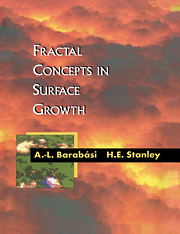Book contents
- Frontmatter
- Contents
- Preface
- Notation guide
- PART 1 Introduction
- PART 2 Nonequilibrium roughening
- PART 3 Interfaces in random media
- PART 4 Molecular beam epitaxy
- PART 5 Noise
- PART 6 Advanced topics
- 24 Multi-affine surfaces
- 25 Variants of the KPZ equation
- 26 Equilibrium fluctuations and directed polymers
- PART 7 Finale
- APPENDIX A Numerical recipes
- APPENDIX B Dynamic renormalization group
- APPENDIX C Hamiltonian description
- Bibliography
- Index
24 - Multi-affine surfaces
Published online by Cambridge University Press: 23 December 2009
- Frontmatter
- Contents
- Preface
- Notation guide
- PART 1 Introduction
- PART 2 Nonequilibrium roughening
- PART 3 Interfaces in random media
- PART 4 Molecular beam epitaxy
- PART 5 Noise
- PART 6 Advanced topics
- 24 Multi-affine surfaces
- 25 Variants of the KPZ equation
- 26 Equilibrium fluctuations and directed polymers
- PART 7 Finale
- APPENDIX A Numerical recipes
- APPENDIX B Dynamic renormalization group
- APPENDIX C Hamiltonian description
- Bibliography
- Index
Summary
Thus far, we have seen that many surfaces are self-affine, and their scaling can be characterized using a single number – the roughness exponent α. This is because the statistical properties characterizing the surface are invariant under an anisotropic scale transformation (3.4). For characterizing the scaling properties of some surfaces, however, the roughness exponent by itself is not sufficient.
In this chapter, we discuss a class of surfaces whose scaling properties are describable only in terms of an infinite set of exponents. Since this class is an extension of self-affine surfaces, we will call them multiaffine surfaces. We shall see that the multi-affine behavior is reflected in the existence of an entire hierarchy of ‘local’ roughness exponents, i.e., the roughness exponent for multi-affine interfaces changes from site to site.
A number of models studied recently in the literature lead to multi-affine surfaces. For example, if the noise in the system has a power-law distribution, the interface is multi-affine for length scales shorter than a characteristic length scale ℓx, set by the noise (see §23.3). Similarly, the temporal fluctuations of the interface width in the saturated regime leads to a multi-affine function. Quenched noise, present in many experimental systems, leads naturally to power-law distributed noise, so one expects that multi-affine behavior might be present in such systems as well. Indeed, Sneppen and Jensen studied the temporal properties of the SOD model discussed in §10.2, and found this type of multi-affine behavior.
- Type
- Chapter
- Information
- Fractal Concepts in Surface Growth , pp. 262 - 268Publisher: Cambridge University PressPrint publication year: 1995
- 1
- Cited by

